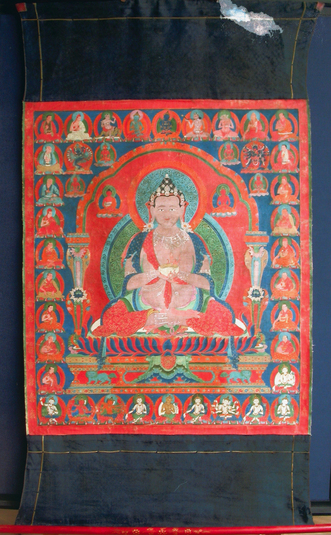
Item: Indian Adept (siddha) - Kanha (of the East)
| Origin Location | Tibet |
|---|---|
| Date Range | 1500 - 1599 |
| Lineages | Sakya, Ngor (Sakya) and Buddhist |
| Material | Ground Mineral Pigment on Cotton |
| Collection | Private |
Classification: Person
Kanha of the East, 8th century (Tibetan: nag po pa shar chog pa): one of the principal students of mahasiddha Virupa along with Dombi Heruka. The surrounding lineage in the upper and side registers is for the Crooked and the Straight, or Crooked Made Straight Lineage of the outer Margapala teachings.
Kanha was a lineage teacher of the Margapala (Path Together with the Result) teachings preserved in the Sakya School. Kanha is famous for teaching the gradual method Margapala while Dombi Heruka was responsible for carrying on the sudden method Margapala. (See the list of teachers).
"With the profound advice, release my mind, Performing the benefit of others With the practice of vows; To Kanha I bow. (Chogyal Pagpa).
Video: Kanha & Krishnacharya
The Path of Chandali [lineage], the Completion and the Two Paths, the Crooked and the Straight: Vajradhara, Vajravarahi, Jalandharapa, Kanha, Dramze Paldzin [Shridhara], Gayadhara, (etc. the same as from the Margapala Lineage) [...Je Drogmi Shakya Yeshe, Je Khar Chungpa Kunrig, Je Shang Gonpawa Chobar, Je Sakyapa Chenpo Kunga Nyingpo, Lobpon Rinpoche Sonam Tsemo, Jetsun Rinpoche Dragpa Gyaltsen, Chokyi Je Sakya Pandita Chenpo, Lama Chokyi Gyalpo (13th century)].
Lower Register Figures from the Bari Gyatsa: 7. Maha Raja Manjushri 8. Vidyadhara Pitaka Samskipta Manjushri 9. Ananga Vajra Manjushri 1O. Dharmadhatu Vagishvara (Manjushri) 11. Manjushri Namasangiti 12. Siddha Kavira (Manjushri) 13. Manjushri Prajna Chakra
Along the bottom register are nine forms of Manjushri drawn from the text known as the Bari Gyatsa. Five additional forms are located on the preceding painting of the Mahasiddha Virupa.
[7] Maharaja Manjushri. [Above] a lion, lotus and moon...is Manjushri with a body orange in colour, one face and two hands, seated in the lalitaraja [posture]. The right hand is extended with the palm down on the right knee, the left holds to the heart a blue utpala stem, with the petals blossoming beside the ear, the same ornaments and garments.
[8] Vidhyadhara Pitaka Samkshepta. [Above] a lotus and moon is white Manjushri Arapachana. Holding a sword and a book, the same ornaments and garments, seated in the lalitaraja [posture].
[9] Anangavajra Manjughosha. Anangavajra Manjughosa, a body yellow in colour, with six hands. The first two hold a flower bow drawn near to the ear with the arrow tipped with a red utpala [flower]. The middle two hold a sword and blue utpala, the lower two, a mirror and branch of the ashoka tree. With the same ornaments and garments. Seated in a manner with the left leg extended.
[10] Dharmadhatu Vagishvara. White Dharmadhatu Vagishvara, with four white faces, eight hands, the first two in the Dharma teaching gesture. The three lower right hold a sword, arrow and vajra. The three lower left, a Prajnaparamita book, bow and bell. With the same ornaments and garments. Seated in the vajrasana [posture].
[11] Manjushri Namasangiti. Lord Manjushri, with three faces and four hands. Having a reddish tinge the body and main face are white. The first two hands hold a sword and book, the lower two an arrow and bow, with the same ornaments and garments.
[12] Arya Manjushri Vajra Siddhi Kavira. White Siddhi Kavira, with one face and two hands, the right [in the gesture of] supreme generosity, the left holding a blue utpala [flower], the same ornaments and garments. Seated in the vajrasana [posture].
[13] Manjushri Prajna Chakra. White Manjushri Prajna Chakra holding a sword and book, with the same ornaments, garments and posture as before.
Jeff Watt [updated 4-2023]
Subject: Margapala/Lamdre Lineage [1] (Ngor set)
MH Private (Painting)
Subject: Kanha & Krishnacharya
Indian Adept: Kanha Masterworks
Indian Adept: Kanha of the East Page
Indian Adept: Siddha Appearance Masterworks (Painting)
Indian Adept (Mahasiddha): Painting (Middle Period 15th-16th)
Subject: Margapala/Lamdre Lineage [1] (Ngor set. Indian Figures)
Subject: Margapala/Lamdre Lineage [1] (Bari Gyatsa)
Subject: Margapala/Lamdre (Lotus Pair 2)

